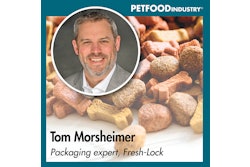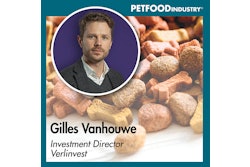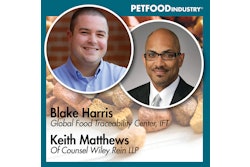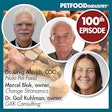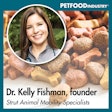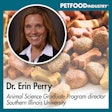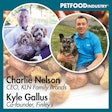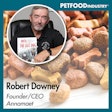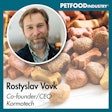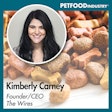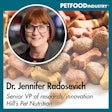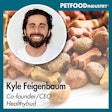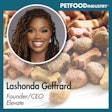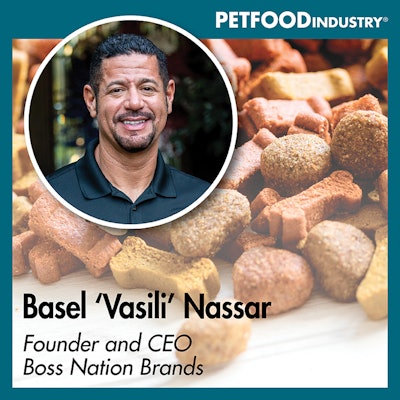
Lindsay Beaton spoke with Basel “Vasili” Nassar, founder and CEO of Boss Nation Brands, about the latest trends in pet probiotics and gut health and where the market might be headed in the latest episode of Trending: Pet Food.
The below transcript is from Episode 55 of the Trending: Pet Food podcast where editor Lindsay Beaton spoke with Basel “Vasili” Nassar, founder and CEO of Boss Nation Brands, about the latest trends in pet gut health and where the market might be headed. You can find the episode at PetfoodIndustry.com/trending-pet-food-podcast, on SoundCloud or on your favorite podcast platform. This episode originally aired on February 14.
We want to thank AFB International for sponsoring this podcast. AFB is the premier supplier of palatants to pet food companies worldwide, offering off-the-shelf and custom solutions and services that make pet food, treats and supplements taste great.
Lindsay Beaton – Editor, Petfood Industry magazine and Host, Trending: Pet Food podcast: Hello, and welcome to Trending: Pet Food, the industry podcast where we cover all the latest hot topics and trends in pet food. I’m your host and editor of Petfood Industry magazine, Lindsay Beaton, and I’m here today with Basel “Vasili” Nassar, the founder and CEO of Boss Nation Brands. Hi Vasili, and welcome.
Vasili Nassar, founder and CEO, Boss Nation Brands: Hi, Lindsay. Thanks for having me today.
Beaton: In case you’re not familiar with Vasili or his company, here’s what you need to know.
With a remarkable career spanning over 25 years, Vasili has been a driving force in the creation of industry-leading innovations across both consumable and non-consumable goods. Notably, he cofounded 3 Greek Gods, a trailblazing brand in the Greek yogurt retail space, steering its growth to an impressive portfolio value exceeding US$100 million. A seasoned entrepreneur, Vasili remains at the forefront of his field, actively collaborating with his dedicated team to forge new paths, innovate, and capture market share.
Boss Dog and Boss Cat brands, which together make up Boss Nation, stand out as top-tier providers of premium pet products, committed to pet gut health solutions and well-being of pets. Focusing on digestive health, the brands present a range of innovative products made from premium ingredients and backed by scientific research.
Vasili’s experience and obvious passion for pet gut health, as well as gut health’s current top-of-mind place in the pet food industry, are why I’ve brought him on today to answer this question: What is the latest in pet gut health when it comes to pet food?
I always like to start with a little bit of history. We know where we've been and can we talk about where we're going. What has the evolution of interest in pet gut health look like over the last several years? Because we're in a very different place now than we were several years ago.
Nassar: Absolutely. I think what inspired me to get into the pet industry -- late 2018-2019 is when we introduced our first line -- was the fact that there was very limited gut health solution in pet specialty or pet conventional. We wanted to take that knowledge and apply it. Nowadays, I can tell you that we're starting to see other brands emerge, with added probiotics similar to what we're doing. Quantification is becoming a big piece in how many probiotics you're getting deliverable, and then functionality ultimately in the different strains. That's what I'm seeing in the last couple of years. I have to tell you, having only been in the industry for five years, the move to digestive health solutions has been one of the fastest I've ever seen.
Beaton: Was there any kind of connection between your previous work in Greek yogurt and coming into the pet space? Because yogurt has a long history in the human space of being something that's looked toward as a gut health thing ever since probiotics hit the scene?
Nassar: Oh, absolutely, Lindsay. There were a lot of parallels between what we did in Greek yogurt and really more over everything else that we infused with probiotics. One of the challenges working with probiotics is what type of probiotic to use, at what quantity and then where to introduce it in the process. We had learned by making Greek yogurt for 20 years, one way of utilizing probiotics, then we were challenged with building out a refrigerated division. That's when soup bases, plant-based solutions were brought to me and we learned how to infuse accordingly.
The pet industry offers a few other challenges that we didn't see – high-pressure pasteurization, freeze drying, so there was a learning curve that was actually pretty swift for us in trying to figure out what to use and when. Between myself and Dr. Moe Barney, who heads up our regulatory group, we really feel as if we're the front runner in digestive health solutions for pet.
Beaton: You mentioned that there are challenges in the pet food space when it comes to using probiotics. How much of that is formulation? And how much of it is the mode of delivery? Is it easier or more difficult to put probiotics in kibble where you're using the extrusion process that could kill off some of that or fresh food or frozen freeze-dried. What conveys probiotics the best and what presents some additional challenges when you're trying to work with these different types of methods?
Nassar: Given the fact we're all in the business of trying to generate profit, I can tell you the biggest obstacle is economics. If you're using the right probiotic at the right level, they can be upwards of $800 to $1,000 per kilo. If we're coming out of what I call “100 years of kibble and bits” when just conventional extruded kibble was pretty much all you fed, now we're forcing the brands in the industry to add value. I think the biggest barrier to that as cost. Process would probably be the next piece, when to introduce it between your kill steps. Then again, how much to use of what. Those are still a bit of an uphill climb for a lot of the brands that we've really mastered in the last five years.
Beaton: Is there any sort of industry standard in terms of how much of a strain of probiotic you should use for it to have reasonable efficacy when you're marketing it to pet food consumers? Or is everybody just kind of trying to do their own thing and meet whatever internal standards they have?
Nassar: That’s a phenomenal question, and I'll tell you, it's one that should be asked more often. The standard in the human world is a billion probiotics colony-forming units for you to be able to make a probiotic claim. We took liberty to do in some cases 2 billion per ounce or 500 million per patty to establish what we think should be a standard.
In pet, if you're going to make a digestive health claim or an immunity claim, you need to be able to use levels that are sustainable, and that also have the capability of getting all the way through colon or rectal, all the way through the stomach acids. There are other things that we do, for example, like using inulin as a prebiotic to help encapsulate the probiotics, so it has long-term survivability.
There's a lot of education, I think that AAFCO and the rest of the industry will hopefully adopt over time. When we hear of changes that are happening, that embrace these -- I don't want to use the word “trends” -- but these trends or these new benefits for your pets. We just hope that at some point, we look at some of the parallels in the human industry and try to adopt the same standards. I think a standard really should be set before it becomes a free-for-all.
Beaton: Now you said the magic word “education.” I love a good education conversation. So here we go, listeners, you know that I like to dive into it if I can. Where are we at in terms of educating consumers on the pet side about probiotics? It used to just be probiotics, then prebiotics came in, and now there are postbiotics. You can use them in different ways for different things. What kind of handle do you feel like your customers have on that sort of thing? And then the industry in general, how is it doing in terms of educating pet consumers?
Nassar: Well, you know, there's this interesting trend that you heard me allude to just a minute ago. There's a parallel between human consumption and pet consumption. In some cases, there's not a lot of logic to it. I eat kale, therefore, my dog should eat kale. Okay. There's the idea that they should eat something akin in the wild.
I think educating the customer is the biggest challenge, because there's a distinct difference between a human digestive system and an animal's digestive system, in terms of what the animal intakes and what the human intakes. For us, it's education. We have a great training video that takes you on the life of a probiotic spore. It shows you its evolution through the stomach, how we encapsulate it with the prebiotic, and then ultimately how it passes all the way through to do what it's meant to do. I think consumers need to see the benefit.
We have -- it’s called Boss Ranch -- we have four big dogs here, a couple little guys, two cats and a giant tortoise, and then most recently Maxi, our golden conure, which was a surprise. I can tell you transitioning all of them to raw, or freeze-dried raw feed, was a process. One, it doesn't happen immediately. It's meant to be transitional. Generally, the benefits don't come until over time. But I can tell you the difference – and there's really no romantic way to put this -- the biggest difference we see in the animals’ output. Their moisture retention, their ability to maintain nutrients longer, and thereby benefit what we see in the coat, breath, teeth. Over the course of about three months is where we really started to see it, and that’s when I think the consumer will finally understand why probiotics play.
Now as a brand, it's on us to try to communicate that message. We do that by using the BC30 Probiotic logo, having the informational videos, and then most recently, on all of our freezers, we have a QR code with a 30-second “Why Boss Dogs Probiotics for Your Pet?” It's continual direct and passive education.
Beaton: What are you finding that people are asking for in terms of gut health solutions? Is it “my animal has a problem and I need a solution” or are they switching to preventive maintenance? What are they looking to address most specifically, right now?
Nassar: I would say it’s 80/20 – 80% being “we have a problem, we need a solution,” which I think is consistent with most of us. We don't react to it until it becomes a problem. Then the other 20% are preventative. That's a really easy question to answer, it just boils down to a result.
If you have an animal that has digestive issues, having a tough time retaining their intake, you'll see that result, generally very quickly, as you transition over to a heavily probiotic-loaded food. That's where I believe people will recognize it right away -- if their animal had an issue and has had problems consuming foods and retaining.
The other piece that we recommend is rotating the proteins. That's why we offer four different proteins. There are some animals that are allergic. I’ve got six dogs here, ultimately if we get the bernedoodle that we want for Christmas. I can tell you, we don't have any finicky dogs. I hear stories all the time of this one is and -- the fact that matter is, if you're consistent with your feeding, if you're consistent with your supplementing, and you're treating -- because supplementing and treating always a big part of it -- then you'll see the result.
Beaton: Are you finding that most people are looking for complete and balanced nutrition solutions with probiotics in it? I know you guys do goat's milk and things that would be more of a topper supplement kind of situation, treats. Where are people looking for these kinds of solutions?
Nassar: We're all getting busier. If you look at the way we feed our pets, it's almost an assembly line of dishes. Anything we can do to reduce the number of things I need to introduce to that task is easier for us. We’re all busy, so I think having all-inclusive systems are important. We offer that in our meal systems, be it frozen or freeze dried. By the way, we have that for both dogs and cats in entree form. Then extending that same concept into our treat solutions. Having that variety is what's important.
Beaton: I always like to talk to people who have cat lines, because it feels like everybody has a dog line. Traditionally, dogs have gotten a lot of the love in the pet space and cats are getting more and more. Do cat owners show up with different kinds of problems or are dogs and cats -- not that they have the same physiology -- but do they present with the same types of problems and need the same types of solutions when it comes to their food?
Nassar: Cat formulations took about three times longer than the dog. That's not to say that the dog was shorted in any way. We really wanted to get it right. Any one that's lived on this planet knows cats are finicky as all get out. Getting them to try new food is the biggest challenge, and then getting them to stay with it. We took about seven months to do Boss Cat frozen entrées.
The biggest considerations were the palatant and having a natural palatant that we knew they would love and go for. Then, most importantly, listening to what the raw retailers and raw consumers were looking for.
There was another brand that was on the market for some time, they really reset the segment then unfortunately had to retract the brand. We don't believe that business has been replaced, but we think we're the closest formula and the closest feeding entree that space has seen.
For example, in adult male cat sometimes calcium from the neck bone will cause crystallization and urinary tract issues. It's consistent amongst a lot of adult cats. We took the time to use calcium from eggshell, putting psyllium husk instead of kelp, where a lot of people will use kelp to help prevent the accumulation of hairballs, and then the addition of DHA and then touring as well.
All these things were considered when we formulated the cat. And I'm thankful that we call it -- whether this is appropriate or not -- crack for cats. Even our dogs go nuts over it. It has been one of our slower segments, Lindsay, just because it's a smaller piece of the business. I think consumers are still trying to be brought back to a premium cat entrée since the last brand left several years ago.
Beaton: Now one of the challenges you mentioned is purely a business challenge in that probiotics are expensive as an ingredient. Have they always been that way? Are they getting more expensive because of current economics? Have they always been kind of a high-tier thing? As a business owner who really focuses the brand on that kind of thing, how do you walk that line between this ingredient that's clearly premium no matter what and your customers who are obviously paying for a premium product, but everybody has that line in the sand, right? What kind of conversations do you have around something like that?
Nassar: There's a huge variability in the cost of probiotics, depending on the colony counts per gram, depending on what the functionality, if you're looking for fermentation or just colonies, so that depends as well on. What's important when you look at probiotics is, how many do I believe my pet needs to be functional and healthy? How many do I believe my pet needs to boost immunity? That was one of the biggest published findings that just came out of Kerry Group who makes the BC30 probiotic. We've been waiting for support to suggest that immunity does, in fact, see a benefit from the infusion of probiotics.
The most important thing is quantity at end-of-shelf life. It’s one thing to assume that you have a billion probiotics on day one, but your shelf life could be a two-year package. To be able to have the foresight to front load enough to have survivability.
Lastly, the right probiotic that can survive both shelf life and the acids within the gut. If those things can be accomplished, you generally will have a quality functional premium pet food.
Beaton: Is the research on all that still a work in progress? Or is it more figured out than it used to be, but is there still kind of a dance among different strains and amounts in trying to perfect that formulation and have it meet all of your needs?
Nassar: It's hard to answer that question. How many probiotics does my pet need? Because you're dealing with such a wide variety of breeds, sizes, so on and so forth, and a lot of these findings are recent. I think it's as customers and brands see the benefit of focusing on digestive health solutions, you're going to see the awareness accelerate.
Beaton: Now I feel like this leads a little bit into a conversation about all the microbiome discussions that are happening right now. All the research that's being done in the human space, in the animal space, all over the place right now, it feels like everywhere you turn, there's something about the microbiome and how it's connected to pretty much every system in your body at this point. What kind of opportunity do these kinds of more holistic discussions present for you as a brand that focuses on gut health? Now here we are really focusing on gut health as a driver for other health systems?
Nassar: It's one thing to say we're in the digestive health business and another to resonate with retailers and customers on a regular level. Leading back to what I was saying, educating the consumer and the retailer as to the benefits. The biggest piece for us in establishing an awareness of the microbiome is our most recent focus on using Boss Dog and Boss Cat as a first-time transitional food. It's really hard just to go into a pet store and say, “We've got a product with probiotics in it!” You're competing with 5,000 other brands all looking for the same seven feet of space.
Our latest focus has been “we know how great we are.” We know what our levels are, they're confirmed, they're qualified, but here's where we really need to resonate with the consumer. Here's how we do it. It's in focusing as a first-transition food, then the consumer sees the benefits thereafter of associating digestive health. That's been kind of the overall strategy.
Beaton: I think that's a really interesting strategy, because there are a lot of levels these days between kibble and raw feeding and very few people -- probably more than used to be -- but very few consumers are willing to jump straight from kibble to raw, which they see is way at the other end of the spectrum. Marketing as a transitional food that would help ease people into that type of feeding. What was some of the thinking behind that? Because that's really interesting.
Nassar: We'll just expect that I think the overwhelming complaint is “my dog has stomach issues” or whatever. I think that was the overall strategy -- how do we take what is overwhelmingly a problem and give these customers a solution? You can pack 24-karat gold and give it away, but if you can't find a medium to market, you'll never get rid of it. It's been a Step One for us.
If you see the image behind me of the dog and a cat pushing away pathogens, that's been our visual for the last three years. You'll continue to see that evolve, and I'll give you a hot-off-the-press too before I forget. You see the two brand pillars, Boss Dog and Boss Cat? Don't be surprised if you see a third pillar -- Boss Bird.
The objective on day one has been a lifestyle solution, so if you're a pet owner and you have a household of pets like we do, we want to offer a solution for every pet in the household, if we can. We want to offer quality, qualitative and quantitative solutions, so if you walk in whether it's raw goat milk, like you said, with pumpkin, organic pumpkin, or tripe treats or freeze-dried meatballs, there's a different solution all throughout the store that gives you the benefit you're looking for. I think that's really what my strategy was on day one. Now, the barriers of entry and pattern are extremely high, so am I where I want to be? Every day is a struggle, but we're very thankful to still be in the game.
Beaton: Given everything we've talked about, I want to wrap up with something future-focused, because by the time this episode airs, it is going to be freshly 2024 with plenty of time to still see where the year is going to go. In terms of gut health, where do you think the industry is as an evolution of the idea? And what are you expecting to see in 2024? Is there anything you're particularly excited about in terms of the probiotic, gut health, microbiome -- take your pick -- segment that's going on right now?
Nassar: I think the internal studies being done with our probiotic supplier are one of the biggest things I'm excited about this next year. I can't go into too much detail, but there's a very extensive study happening currently that I believe is going to reveal a lot about how much protein, what type of protein certain dogs may or may not need, and then even lead into probiotic quantification for digestive health and how much. I think will be very revealing. We'll be right in front of all those findings.
From the standpoint of innovation and an extension here, we've got an extensive line now. I think all segments in, we're about 270 SKUs. I would say look for probiotic extensions with unique proteins. Look for the possibility of medley solutions where pet parents are trying to find ways to help reduce the costs but still offer a premium diet.
We're looking at a variety of different ways to either help expand the message that we've already created, but then also be realistic of the economy that we're in today. That’s one of the biggest pushbacks on premium pet right now is just economics and the ability for the market to support it. Like anything, if you want the quality and the freshness, it generally comes at a cost. We believe the market will continue to support premium pet.
Beaton: I really appreciate you coming on with me today to talk about this, because it's such a hot topic right now. There's so much going on. I think as the discussions about microbiomes and the research continue to come out in the next few years, it's really going to become a richer tapestry in terms of a segment and an opportunity for the pet space.
I really appreciate having you on and being able to talk about dog and cat and human and animal. It's always good to get somebody who has a really broad view. Before we go, let's do a little plug. Where can people find more information about you and about Boss Nation brands?
Nassar; Well, you can find a little bit more about us at bossdogbrand.com or bosscatbrand.com. Those are also both of our social media handles. There’s a lot of content there – recipes, store locators. You can get a little bit more about myself and my team, very proud of my team. Most of the people on my team had been with me for five to 10 years or more and prior businesses that came over for this particular venture. I wouldn't be doing this without that group. Go Boss Dog! Go Boss Cat!
Beaton: That’s it for this episode of Trending: Pet Food. You can find us on PetfoodIndustry.com, SoundCloud or your favorite podcast platform. You can also follow us on Instagram @trendingpetfoodpodcast. And if you want to chat or have any feedback, I'd love to hear from you. Feel free to drop me an email: mailto:[email protected]. And of course, thanks again to our sponsor AFB International, the premier supplier of palatants to pet food companies worldwide offering off-the-shelf and custom solutions that make pet food, treats and supplements taste great. Once again, I'm Lindsay Beaton, your host and editor of Petfood Industry magazine, and we'll talk to you next time. Thanks for tuning in!



